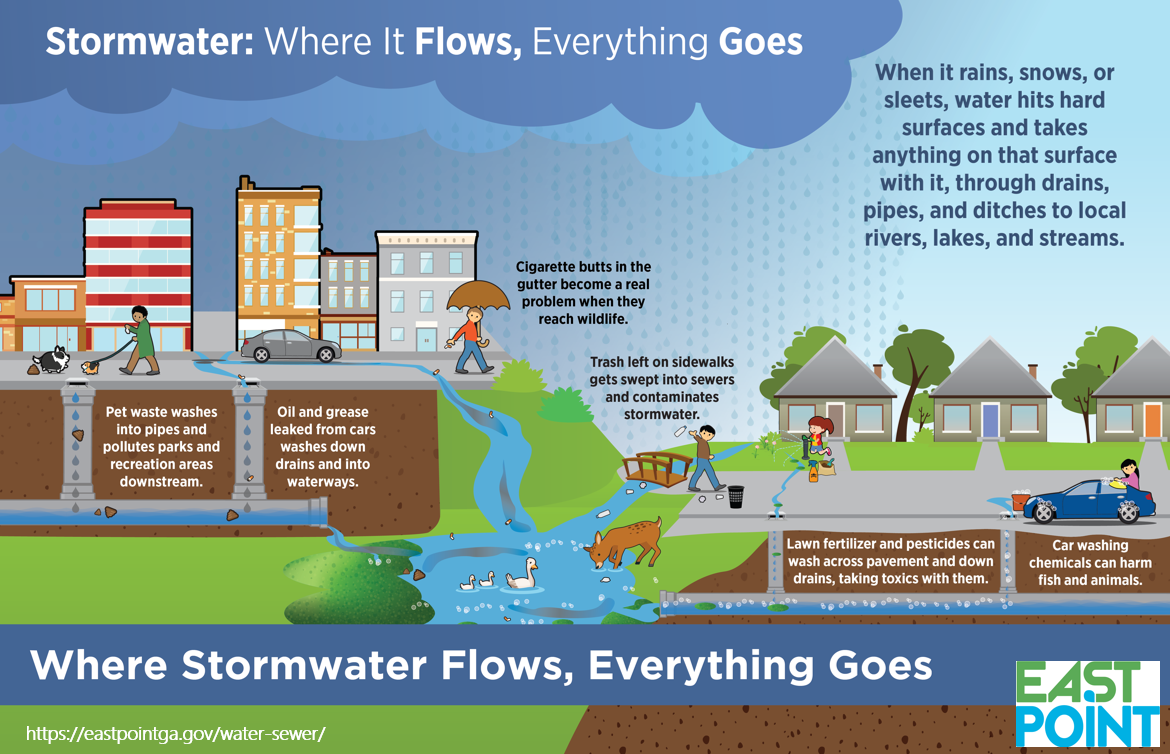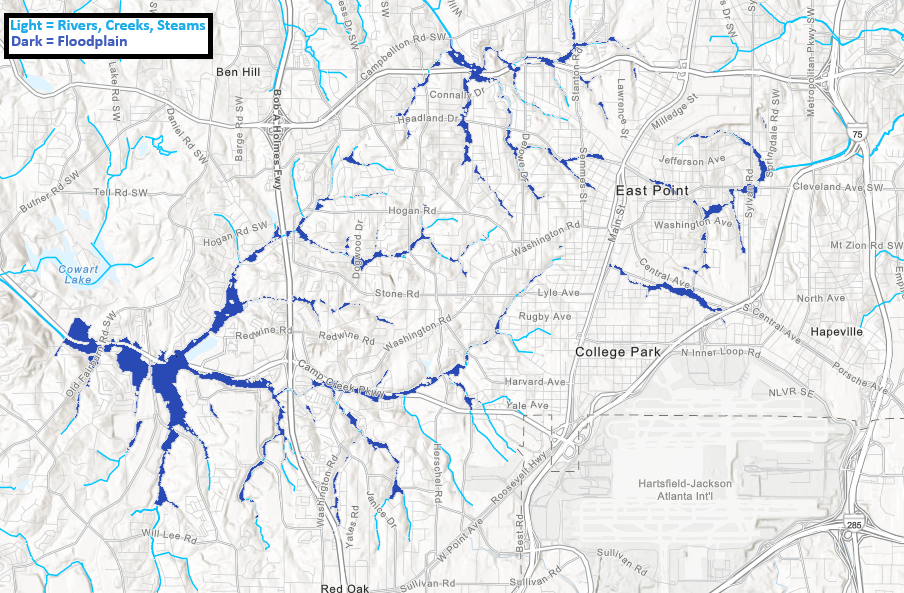
Water & Sewer
Stormwater Division
The Water & Sewer Department provides municipal water and wastewater products and services and strives to provide progressive administrative oversight and management of resources.
East Point City Hall
2757 East Point Street
East Point, GA 30344
Hours of Operation
Monday through Friday
8:00 AM to 5:00 PM
Stormwater Management Regulatory Program
East Point is subject to a wide variety of flood risks. Flooding most commonly occurs during the rainy season from June to November. Low-lying areas near streams are particularly subject to flooding. Several areas of the city have experienced flooding from Camp Creek, Utoy Creek, and South River. The City’s most recent major flood events occurred in the fall of 2009 and the winter of 2010. Several properties within the City suffered flood damage. In these events, flood waters ranged from 1 to 3 feet in some areas. Residents shall be reminded that flood waters are dangerous. Six inches of water will reach the bottom of passenger cars and cause a loss of control and possible stalling. A foot of water will float many vehicles. Two feet of rushing water can carry away most vehicles including sport utility vehicles (SUV’s) and pick-ups.
Your property may be high enough that it has not flooded recently. If your property is in the floodplain, the odds are that someday your property will be damaged by flood. According to the East Point Flood Damage Protection Ordinance, if cumulative substantial improvements to a building over 10-years are more than 50% of the current market value, the entire building must be protected from flooding according to new building standards.
Learn more:
BE FLOOD SAFE!
It is important to recognize the power of floodwaters and to take proactive measures to prevent injury or death. Drowning is the number one cause of flood-related deaths; just six inches of moving water can be enough to knock an adult off their feet.
DO NOT walk through flowing water. Use a stick, pole or similar tool to walk in standing water to avoid falling into holes and other hidden dangers.
DO NOT drive through a flooded area or around barriers. In floods, more people drown in cars than anywhere else, and barriers may indicate a road or bridge is washed out.
DO NOT touch or go near downed power lines or electrical wires. The number two cause of death during flood events is electrocution. Immediately report downed power lines to East Point Power at (404) 270-7125.
DO NOT use appliances or motors that have gotten wet, even if they were unplugged before being touched by water. Appliances may keep electrical charges even after they have been unplugged. reconstruction, rehabilitation, addition or other activities.
Always check with the city before you build, alter, re-grade, or fill on your property. A permit may be needed to ensure that projects do not cause problems on other properties. If you see building or filling without a city permit posted, call (404) 765-1144 to report your concern.
The water distribution system is comprised of a main line that runs 164+ miles. The main lines range in size from 2” – 16”. The Waterline Maintenance Division is responsible for the installation, repair and maintenance of all water mains, service lines, valves, and fire hydrants.
The collections system contains 153+ miles of sewer main lines. The Sewer Line Maintenance Division is responsible for the installation, repair, and maintenance of all sewer mains and manholes. In addition, the Division is tasked with the following: 24-hour response to sewer overflows and back-ups; maintenance of air relief valves, and force mains, tap/stub location and installation, Closed Circuit TV Inspections of newly developed projects and existing lines, as well as easement encroachment investigations. This Division is responsible for the reduction or elimination of inflow and infiltration into the sewer system. Furthermore, the Division handles sewer rehabilitation projects, flow management, and provides asset management information on the collections system. The Environmental Compliance Division, which includes the FOG (Fats, Oils, and Grease) Program, is responsible for educating the public on keeping the sewer system free of fats, oils, and grease.
The Meter Services Division, also known as Meter Maintenance and Repair, is responsible for the installation, maintenance, and repair of water service lines and water meters in the City of East Point.
The Backflow Prevention (and Cross-Connection) Division is responsible for the installation and inspection of residential and commercial backflow devices.
The City of East Point implemented the Storm Water Division in 2012. This division provides support for major storm water functions such as replacing storm drain pipes, reducing flooding, fulfilling regulatory requirements, and reducing pollution carried by storm water to our waterways.
CITY FLOOD SERVICES
The City of East Point provides resources for property owners to determine their flood hazard and their options for flood protection. Flood maps and flood protection reference materials are available at the office of the Storm Water Division at City Hall located at 2757 East Point Street, East Point, Georgia 30344. The Storm Water Division also has information about area floodplains, as well as maps to show Special Flood Hazard Areas (SFHAs), flood zones, and flood elevations. Copies of Elevation Certificates and historical information about past flooding problems and flood depths are maintained by the same office. The Water and Sewer Department conducts site visits to review flooding, drainage, sewer problems, and to give advice to property owners. Call (470) 303-2334 to receive more information or schedule a visit.
FLOOD WARNING SYSTEM
The most serious threat of general flooding is during the hurricane season (June through November). Residents should stay tuned to television and radio weather broadcasts for special alerts, warnings and advisories. The City of East Point uses the CodeRED Emergency Notification System to inform residents of tornado, flash flood, and severe weather warnings by calling your home or cell phone. You are encouraged to register for CodeRED through the City’s website.
Please call the Storm Water Division at (470) 303-2334 or (404) 559-6380 to report the following:
- Report illegal dumping in storm drains
- Request drainage system maintenance
- Flood Zone Determinations
- To request copies of Elevation Certificates
FLOOD INSURANCE
Talk to your insurance agent if you don’t have flood insurance, because homeowner insurance policies do not cover damage from floods. Because East Point participates in the NFIP, you can purchase a separate flood insurance policy. This insurance is backed by the federal government and is available to everyone, even for properties that have been flooded previously. Some individuals have purchased flood insurance because it was required to obtain a loan. Usually, such policies cover a structure and not its contents. Flooding in East Point usually causes more damage to what’s inside a building as opposed to the building itself. So, if you have a flood insurance policy, be sure the building coverage is adequate and make sure you have contents coverage.
Don’t wait for the next flood to buy insurance! There is a 30-day waiting period before NFIP coverage takes effect. Contact your insurance agent for more information on rates and coverage.
FLOOD INSURANCE RATE MAP INFORMATION
>> Search the map here for your property’s specific flood risk. <<
The East Point floodplain management program provides information to inquirers from the communities Flood Insurance Rate Map (FIRM), including whether a property is in a flood hazard area and its base flood elevation. To obtain FIRM information contact Eric Emmett at (470) 303-2334 or eemmett@eastpointcity.org.
FLOOD PROTECTION LIBRARY (LIB)
- Above the Flood: Elevating Your Floodprone House, FEMA-347 (2000)
- Answers to Questions About the National Flood Insurance Program, F-084 (2011)
- Coastal Construction Manual, FEMA-P-55, (2011)
- Elevated Residential Structures, FEMA-54 (1984)
- Protecting Manufactured Homes from Floods and Other Hazards, FEMA P-85 (2009)
- Mitigation of Flood and Erosion Damage to Residential Buildings in Coastal Areas, FEMA-257 (1994)
- Protecting Building Utilities From Flood Damage, FEMA-P-348 (1999)
- Protecting Floodplain Resources, FEMA-268 (1996)
- Reducing Damage from Localized Flooding, FEMA 511 (2005)
FLOOD ZONE DISCLOSURE RESPONSIBILITIES FOR REAL ESTATE AGENTS
FEMA and Flood Zones: Real Estate Agent Frequently Asked Questions
NATIONAL FLOOD INSURANCE PROGRAM
Click here for information on the National Flood Insurance Program (NFIP).
COMPLIANCE
Every year flooding causes more property damage in the United States than any other natural disaster. While recent construction practices and regulations have made new homes less prone to flooding, many existing structures remain susceptible. Throughout the county there is a growing interest from property owners to develop practical and cost-effective methods for reducing or eliminating exposures to flooding. Several effective methods include acquisition, relocation of a building to a site not subject to flooding, demolition of a structure, or retrofitting.
Retrofitting is when the property itself remains subject to flooding, but the building is modified to prevent or minimize flooding of habitable space. There are several approaches to retrofitting, including elevating the structure, wet flood-proofing, dry flood-proofing, and relocation.
In the event of a flood threat, it is advisable to take the following emergency actions:
- Place sand bags to reduce erosion and scouring
- Elevate furniture above flood levels
- Seal off sewer lines in the dwelling to prevent the backflow of sewer waters
Contact Us

Melissa Echevarria
Director
 Office
Office
(404) 270-7010

